No products in the cart.
Uncategorized
SMALL MAICOS: THE 125s
Chapter 2.3 Part 1
SMALL MAICOS: THE 125s
Although known primarily in the United States as a producer of large, powerful, off-road motorcycles, Maico was certainly no stranger to smaller bikes and road motorcycles. As we have seen, the company began by manufacturing small motorcycles, 200cc-and-under, which were initially used as personal transportation in Germany.
Later, Maico gravitated to the off-road motorcycles which built its American reputation. Still, during its heyday in the 1960s and 1970s, Maico’s line-up included small motorcycles and also an array of 50cc mini-cycles and mopeds for the European market. Since the large off-road motorcycles made the Maico name so well-known in American racing circles, it is not surprising that some of these riders sought out the smaller bikes as well.
The company made a 123cc K125 model as early as 1939, introduced the M125 in 1948, and followed these with the M126 in 1951. All these models were simple 52 x 58 mm (bore/stroke), piston-port two-strokes. A variety of follow-on and larger two-stroke models came later, all piston-port induction, to include Maico’s successful 175 and 250 Scramblers and enduros, and the 250 Blizzard. The Maico 125 that Americans would come to know best was introduced the United States in 1968 as the MC (or GS, if equipped with lights) 125. This first MC125 featured a distinctively tiny squared-off cylinder and head sitting atop sandcast cases, appearing diminutive in the big Maico chassis. Also, for the first time, Maico incorporated rotary-valve induction directly into the crankcase from the carburetor, mounted low on the right side. The engine produced more pure horsepower than nearly any other 125 of its period. Housed in the rugged, proven full-size Maico frame, it should have been exceptional. It was and remains a curious, fascinating, and often frustrating motorcycle
125 Men
The three men interviewed here for their knowledge of Maico 125s had different exposures to and experiences with the machine. One owned a Maico MC125 as a youth, and only briefly; one first dealt with Maico as a young German and then dealt exclusively with road-racing RS125 Maicos after immigrating to the United States; and the third gravitated to MC and GS125s very early and stayed with them for nearing 50 years. One had a difficult relationship with his machine—as did many owners of Maico 125s—while the other two spent the time to understand their machines’ weaknesses and strengths, and succeeded notably in their competitive riding. In all three cases, the Maico motorcycle held considerable meaning for its owner.
Each of these men came from mechanical backgrounds. Two continued in careers (masonry and auto mechanics) while one founded his own engineering firm and retired, following the firm’s sale. All three broke from staid society in at least one way—choosing to race motorcycles—but at the same time would be considered generally conservative in their world views. They are hard-working Americans by any scale. This is their story.
The teenager with the big bike
Craig Shambaugh was a 15-year-old in rural Harrisburg, Pennsylvania in the early 1970s, when he obtained his 125 Maico, by chance, when a family friend put one up for sale. The young motorcycle racer endured a long period of frustration with the machine, but also gloried in owning his first big, serious dirt bike. Reminiscing, he stated “The looks . . . were so appealing at the time. There was just something raw about them; something very business-like. Efficient, no-nonsense. For me, to be able to own a Maico—it was just cool!”[1]Shambaugh dealt with the machine’s difficult transmission for two years, as well as its mechanical unpredictability. “I missed shifts quite a bit. . . . and I never really knew what that bike was going to do in competition.” When the opportunity presented itself, he sold the exotic machine and progressed to a proven, reliable “start it up and go” Yamaha YZ250.

A motorcycle fit for an engineer
Eric Bley grew up in post-World War II East Germany. He came of age riding small street motorcycles for transportation, and eventually road-raced many German and foreign-made motorcycles.[2] A tool-maker by trade, Bley was accepted into engineering school and graduated. Along with his sister, he escaped communist East Germany through Berlin in 1955.[3] After arriving in the United States, he founded Bley Engineering in LaGrange, Illinois, which ultimately prospered. Bley’s financial success and engineering background enabled him to road-race again in America, and among the classic and exotic motorcycles he rode was the rare RS125, the road-racing-only Maico 125 variant. In more recent years, he and his son, Sven, were widely-known in the vintage motorcycle community for their pair of winning RS125s. He recalls, “I had two Maico RS125s; my son raced one and I raced one. One we converted to 175cc; it was fast . . .super fast! We made it ourselves, starting with a 125 and fitting it with a bigger bore and cylinder, different valve timing, and a different crankshaft. It was so fast that my son rode it and he was disqualified! He was a [full] lap ahead of the number-two rider at the end of the race at Daytona! So, the motorcycle was disqualified. It was perfectly legal, but it was simply too fast for them!”
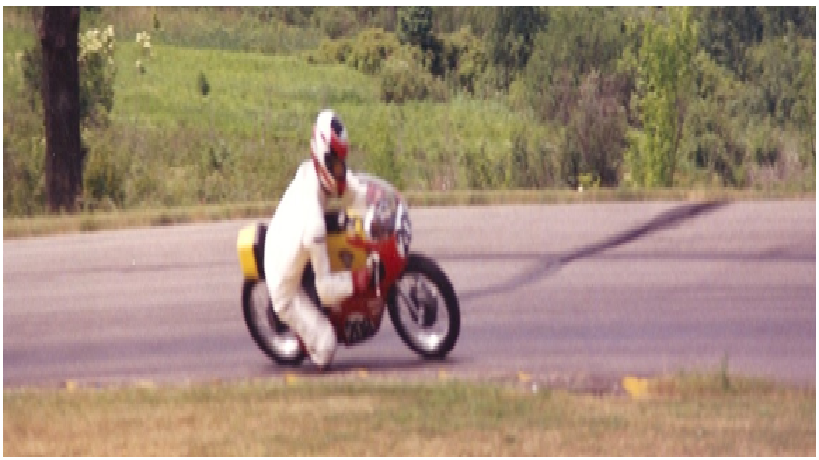
A big-bike rider discovers the 125
Charles Schank began riding larger Maicos in the early 1960s.[4] He competed in both enduros and motocross events around his mid-western home in Flint, Michigan, in succeeding years. Schank was very competitive on what was likely the very first X-4A 360 square-barrel Maico in the United States, winning 13 straight events with it in 1968. He also rode against the European pros in the early Inter-Am North American motocross series, and as he remembers, finished first American and “13th or 14th overall” at New Philadelphia, Ohio in 1968—not bad for “just a weekend rider.” Then, Schank recalls a friend bringing two new Maico 125s to his home in the summer of 1968, a GS and an MC. Something about the machines caught his attention, and he arranged to buy both of them—no small purchase for a young auto mechanic. Schank’s attraction to the 125s was thereafter continuous, and he is today a leading authority on the Maico 125. Schank’s extensive knowledge makes possible the majority of the analysis of the small Maicos which follows.
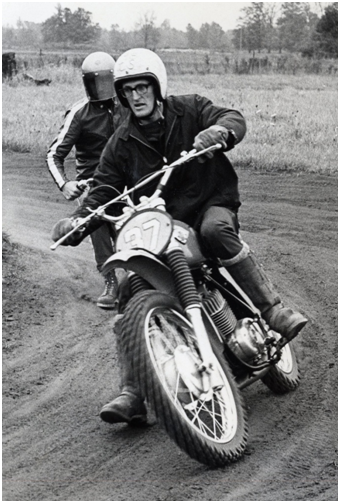
Inside a Swiss watch
Observing the 125 Maico engine—we will analyze an early 1968 five-speed—we can see that it is unlike all the other Maico dirt bike engines, which share similar lower-end case assemblies. The cylinder and head form a squared, ‘squatting’ little finned protuberance atop the cases. The cases themselves are rounded on top and squared at the sides, are unpolished, and the pebbled surface shows evidence of sand-casting. Inside the cylinder is a 54 mm diameter Mahle piston, moving in a 54 mm stroke, and thus achieving a perfect “square” bore/stroke. Designed with a rotary-valve induction system, no carburetor is visible aft of the cylinder; it is hidden beneath the right outer case, with the top extending through a hole just beyond the case cover. A rubber “accordion” tube caries clean air from the standard air-box/air filter assembly under the seat to the right side outer case where the carburetor is housed. Between the little German Bing carburetor outlet and the crankcase inlet is a thin fiber disc rotary valve, splined to and spinning with the crankshaft. The “cutaway” in the disc permits the fuel/air mixture to be drawn into the crankcase by piston-induced vacuum. The size of the cutaway thus determines inlet timing, in conjunction with the two transfer ports and a third, large “bridge” port in the cylinder. The unusual bridge port is not a transfer passage, but rather a chamber cut into the aft of the cylinder. This chamber traps an additional fuel charge, passed to it through a hole in the back of the piston, and then adds this extra potential energy to the total combustible charge. Eric Bley notes that this unique design feature was key to the small Maico’s surprising power output. (And remember that this unique engine was designed without the computer modeling that engineers have at their disposal, today!) The little Maico creates a 10:1 compression ratio, and makes maximum power at a rather high (for a 125cc motocross bike) 8,200 rpm. The higher-tuned road-race RS125 versions create maximum power at 14,000 rpm.
The very long crankshaft initially could be a cause for problems. Schank found this out after an early race, when he discovered the left end of the crankshaft had broken off at a bearing support. This system used an adjustable ball-bearing to support the magneto mass on the far end of the rotating crankshaft, but the bearings were set overly-loose at the factory, inviting lateral play and eventual failure. Schank diagnosed the problem and affected a solution. “After this,” he noted, “I always disassembled my new 125s and tightened up the pre-load a bit on that bearing. I never had a crank failure after that. The five-speed engines all used Bosch magnetos with lighting coils built-in. The enduro models had the wires hooked up for the lights, while the scrambler/motocross models just had the wires cut off. When they went to the six-speed version, they offered two different crankshaft designs: the enduro model still used the long, tapered end so that is could use the Bosche magneto with lights, and the motocross model used a shortened taper; a cut-down version with the APPT magneto—the same as on the bigger bikes.”
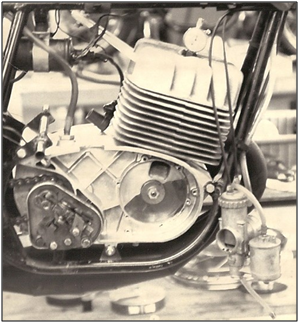
Moving aft of the carburetor, inside the right case, is the gear changing assembly. Contrary to the convention of placing the transmission selector linkage inside the inner engine cases, Maico engineers placed the 125’s linkage outside the right inner case. On the positive side, the assembly could then be worked on without splitting the cases. Unfortunately, as Craig Shambaugh remembers, to get it working correctly “. . . you had to work on it quite often!” The linkage was the Achilles’ Heel of the little Maico. The exposed linkage system is imprecise, tends to come out of synchronization, and is exposed to potential damage in the event of a right-side impact. It is, as Eric Bley stated, “extremely touchy.” Even Wilhelm Maisch Jr. concluded that the 125’s shifting was the reason for its low acceptance in America.[5] Moving the shift lever (on the left side of the case) up and down—with the actual selector assembly located a good eight inches away, on the right side—one senses unsure resistances and imprecise reactions. While total lever “throw” (or, distance) is not extreme, the overall sensation is far from that of the clean-shifting and low-effort contemporary Japanese machines.
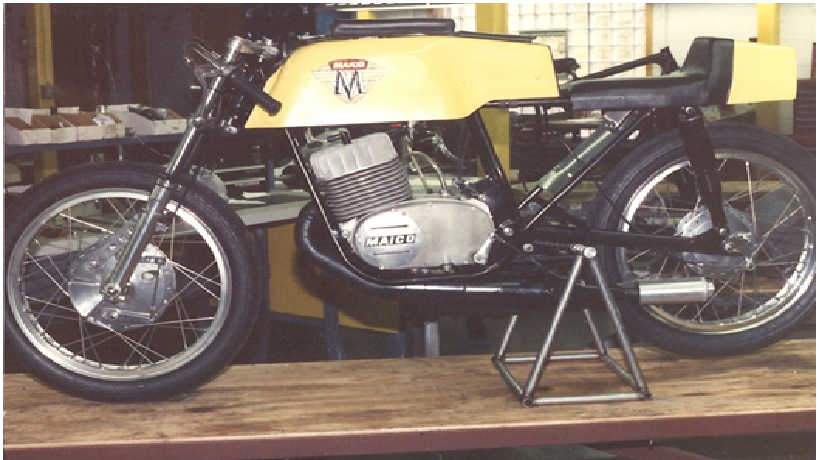
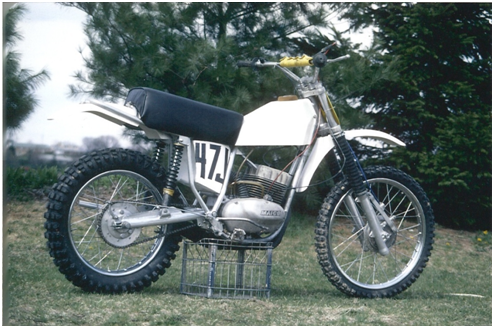
Making it work
Unlike many other off-road riders, Charles Schank was able to live with the Maico 125’s transmission. He learned to make the five-speed models shift reasonably well, employing a bit of care when shifting and with some adaptation to its foibles. When the “more positive-shifting” six-speed transmissions were introduced, Schank felt the 125 to be basically trouble-free—at least for him. He notes also that many other European engine makers, notably Sachs and Monark—and even the Japanese Hodaka—also had similar shifting problems, especially “false neutrals (where the transmission fails to engage, between gears).” Clearly, this was a problem for a number of manufacturers. Like them, Maico received a lasting, damning reputation for their 125’s problems. Still, Schank noted, “over the years, that early crankshaft bearing problem was the only real trouble I ever had with the 125 Maicos.” Reasons for the 125’s bad reputation were varied, but most centered on the transmission. Also—like most any purebred racing bike—the little Maicos were finicky, maintenance-intensive motorcycles.
Moving around the engine to the left side, the kick-starter lever and gear shift lever can be seen—located on what appears to be the same shaft—entering the engine. The assembly is actually two shafts, with the smaller-diameter shift shaft riding within the larger, hollow kicker shaft. The shift shaft continues through the engine, connecting to the gear change (selector) mechanism on the right rear of the engine cases, behind the carburetor. A fork or ‘pawl’ is activated by the gear change assembly, and pushes and locks in place the five gears on the output shaft individually and sequentially, meshing the output shaft gears with the constantly-driven and fixed main shaft gears. When in gear, the appropriate drive gear on the main shaft connects with a fixed gear on the output shaft. The two meshed gears, operating at their set ratio, turn the output shaft, onto which the countershaft sprocket is splined, outside the right-side inner engine case. The countershaft sprocket is connected by relatively light-duty #428 drive chain to the rear sprocket, which turns the rear wheel through a cush-drive design. It is an intricately designedand admittedly fragilesystem.
Moving aft, the rear hub assembly, directly off a 1950s street bike, is connected to an 18 inch chromed steel rim. The rear sprocket is very small, and it barely projects beyond the hub. The entire rear hub and wheel assembly are visibly different from the larger Maicos. Another difference is the engine mounting: the 125 engine mounts to the frame using different mounting points than the other engines, which share the same general case castings and engine mounts. This makes the frame of a 125 Maico easy to identify. Otherwise, the 125 frame is mostly identical to those of the larger Maicos. Using a frame suitable for a 400 or 501’s performance ensured that the Maico 125 was indeed a stable, non-flexing platform. Nestled between the frame rails, under the seat, is an air-box of the same dimensions as the larger machines. It differs only in having a smaller inlet hole, accommodating a smaller-diameter rubber accordion air tube connecting the carburetor cover to the air-box inlet. The air-box on the early five-speed 125 is formed from black ABS-type plastic panels (like similar-year “wide-frame” 250/360/400 models); later versions incorporated fiberglass.
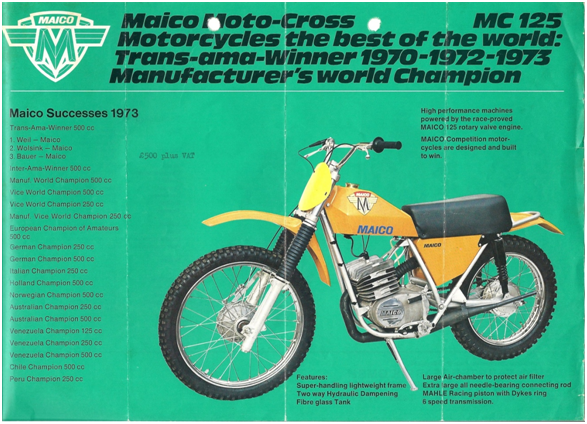
[1] Interview with Craig Shambaugh by David Russell, September 11, 2008, Harrisburg, Pennsylvania (Russell Motorcycle Sport Collection, Center for Pennsylvania Culture Studies, Penn State Harrisburg).
[2]Interview with Eric Bley by David Russell, March 21, 2008, Harrisburg, Pennsylvania (Russell Motorcycle Sport Collection, Center for Pennsylvania Culture Studies, Penn State Harrisburg).
[3]“Berlin Wall Retains East Germans,” The Bryan Times, November 28, 1970. Eric Bley arranged for the escape of his younger brother as well, in a complex jump into the sea in 1970 off the coast of Florida.
[4]Interview with Charles Schankby David Russell, October 6, 2009, Harrisburg, Pennsylvania (Russell Motorcycle Sport Collection, Center for Pennsylvania Culture Studies, Penn State Harrisburg).
[5]Interview with Wilhelm Maisch Jr. by David Russell, (date not recorded) 2008, Harrisburg, Pennsylvania (Russell Motorcycle Sport Collection, Center for Pennsylvania Culture Studies, Penn State Harrisburg).

Iam in the middle of a 1972 mc 400 build
Now and having a time finding a complete radial engine at a good price
I know this bike will be a blast to ride in the dirt
Hey, Tom–yes, the 400 is the classic! Hope you can find one, soon; it’s certainly getting harder. Even back in the 90s, it seemed like we were assembling engines from “a cylinder here, cases there, etc.” One angle is building a big engine from a 250; might take a slight bit of machining on the top of the cases, and you’ll need a used 400/450 crank (inexpensive) and some work finding the right 3-row primary drive/clutch…but it’s do-able. Best wishes! Dave